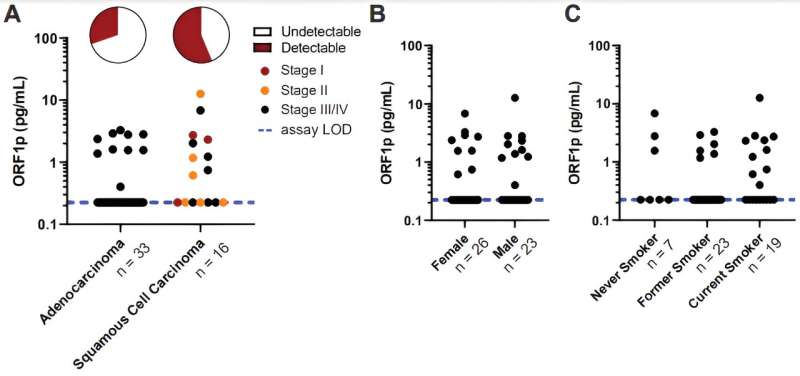This article has been reviewed according to Science X's editorial process and policies. Editors have highlighted the following attributes while ensuring the content's credibility:
fact-checked
peer-reviewed publication
trusted source
proofread
Ultrasensitive blood test detects 'pan-cancer' biomarker

Diagnostic tools for timely, accurate and inexpensive early cancer detection that can assess risk or monitor response to treatment could help patients get the care they need faster and improve existing care strategies. But current cancer assessment methods have limited specificity and sensitivity and can be prohibitively expensive.
In a study led by investigators from Mass General Brigham, the Wyss Institute for Biologically Inspired Engineering at Harvard University and Dana-Farber Cancer Institute, in collaboration with researchers from across the country and beyond the U.S., researchers have developed a low-cost, ultrasensitive blood test to detect minute levels of a cancer biomarker that is highly specific to multiple common cancers.
Each test can be performed with merely half a drop of blood (25 microliters). The tool showed promise for early cancer detection and disease monitoring, and could potentially be used in conjunction with other tools for detection, risk stratification and treatment.
Results are published in Cancer Discovery.
"Cancer biomarker detection is a burgeoning area of research and is still a young field," said co-corresponding author David Walt, Ph.D., of the Department of Pathology at Brigham and Women's Hospital. Walt is also a core faculty member at the Wyss Institute. "Our results show that we can detect levels of this pan-cancer biomarker in the blood of patients with many types of cancers."
The new study leverages a single-molecule-based detection technology known as SIMOA that was developed by the Walt lab. The test is designed to detect the open reading frame 1 protein (ORF1p), a transposable element protein that's known to occur in many cancers but not in corresponding normal tissue, and that can indicate high risk of cancer lethality.
Researchers have long sought a sensitive, accurate test to detect ORF1p. The authors describe their first investigation of the test as a pilot experiment that wound up working better than they had imagined, which was followed by a series of engineering improvements and iterations in patient samples.
"We were shocked by how well this test worked in detecting the biomarker's expression across cancer types," said lead author Martin Taylor, M.D., Ph.D., of the Department of Pathology at Massachusetts General Hospital. "It's created more questions for us to explore and sparked interest among collaborators across many institutions."
Teaming up with investigators across Mass General Brigham, Dana-Farber, Beth Israel Deaconess, and MIT in Boston and from Rockefeller University, University of Pennsylvania, University of Washington (Seattle), Johns Hopkins, Groningen (Netherlands), and Canon Medical, the researchers tested blood samples from patients with different types of cancers, including ovarian and colorectal cancer.
The ultrasensitive assessment tool successfully quantified ORF1p in cancer patient blood samples, but only in very rare "healthy" patients, supporting the specificity for cancer detection. Studies in tissue samples from ~200 colon cancer and 75 esophageal biopsies, obtained from patients at different disease stages, showed that ORF1p tissue expression was prevalent in carcinomas and high-risk precursor lesions.
"Our results bolster the emerging idea that ORF1p expression is a 'hallmark of cancer' expressed starting early in the disease process. Pervasive expression of ORF1p in carcinomas and the lack of expression in normal tissues makes ORF1p unlike other protein biomarkers, which have normal expression levels. This unique biology makes it highly specific," said Taylor.
A limitation of the study is that the results don't provide key pieces of information, such as the location of the cancerous tissues in the body. In addition, the ultrasensitive assessment tool isn't successful in identifying all cancers and their subtypes. The team envisions that the tool could be used in addition to other tests to improve overall early detection testing methods, and to allow doctors to monitor patient response to cancer therapy in real time and make adjustments if needed.
"The test is very specific, but it doesn't tell us enough information to be used in a vacuum," said Walt. "It's exciting to see the early success of this ultrasensitive assessment tool, but there is more work to be done."
The study's pathology researchers are now working with clinicians to study the test's accuracy in larger trial cohorts and different patient populations in order to understand if the assessment of the ORF1p biomarker would be useful for the care of their patients. They are also working to determine whether the biomarker can be used to stratify the risk of cancer in patients.
"We've known since the 1980s that transposable elements were active in some cancers, and nearly 10 years ago we reported that ORF1p was a pervasive cancer biomarker, but until now, we haven't had the ability to detect it in blood tests," said co-corresponding author Kathleen Burns, M.D., Ph.D., Chair of the Department of Pathology at Dana-Farber.
"Having a technology capable of detecting ORF1p in blood opens so many possibilities for clinical applications. We were fortunate to assemble this tremendous team to push the limits of these assays and obtain and test these precious samples. There's a lot of excitement as our work continues."
More information: Martin S. Taylor et al, Ultrasensitive detection of circulating LINE-1 ORF1p as a specific multi-cancer biomarker, Cancer Discovery (2023). DOI: 10.1101/2023.01.25.525462
DOI: 10.1158/2159-8290.CD-23-0313 , aacrjournals.org/cancerdiscove … f-circulating-LINE-1



















